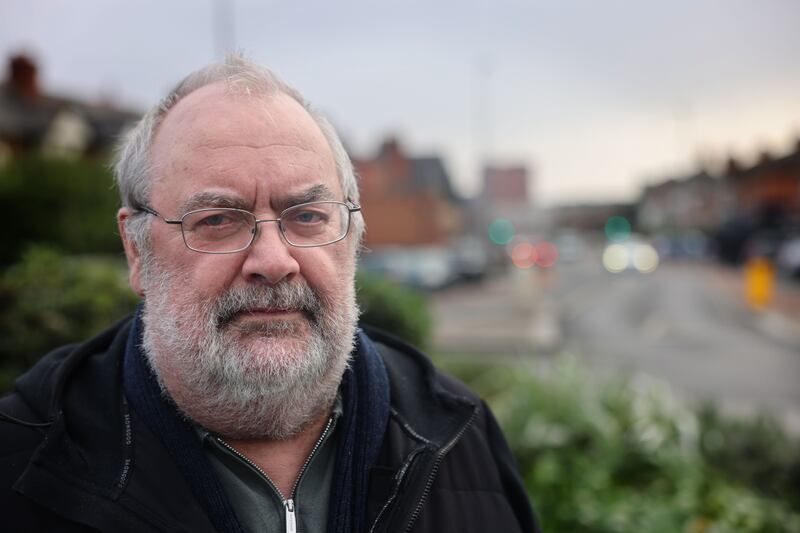For many years at Our Lady of Lourdes Church on Sean McDermott Street in Dublin, there’s been a service to commemorate the thousands who have died as a consequence of Ireland’s ongoing drug epidemic. At these commemorations you can see quilts from different communities; each square of each quilt is embroidered to represent a specific person who died and each year the quilts get bigger.
Barry Cullen is a social worker who worked for many decades in the south inner city before becoming a lecturer and researcher in Trinity College Dublin and later co-ordinated a drugs taskforce in Dún Laoghaire-Rathdown. He recently published a book, The Harm Done: Community and Drugs in Dublin, which documents the heroin epidemic and how wider society dealt with it (or failed to) across decades.
“I was there from the start,” he says. “I was quite conscious during the Citizens’ Assembly [on drug use] that when you get an account of drug policy, the starting point tends to be the mid-’90s but a lot happened before the mid-’90s and that needs to be part of the picture, too.”
[ Fintan O’Toole: A tiny area of Dublin is Ireland’s most segregated districtOpens in new window ]
As a young man in 1975, Cullen got a job at a youth club called the Kylemore Avenue Playground in Ballyfermot, where he grew up. “I was [working] with young people who were on the margins. None of them were injecting at that particular time. They were mainly combining alcohol – cider mainly – with pills, barbiturates... I remember there was one pharmacy had boxes of cough bottles that were opened on dole days. Young people were buying them across the counter.”
READ MORE
Cullen now views the growing social problems they were seeing as a consequence of the disappearance of a lot of unskilled factory work in the city in the second half of the 1970s. In the early 1980s, at which point Cullen was a Trinity-trained social worker working for the health board in the south inner city, the criminal Larry Dunne and his family began importing large quantities of heroin into the city. “I became aware that a lot of the referrals came from the mothers of young people who were on heroin. And some of it was as a result of the young people themselves having children and the parents being very concerned about their grandkids.”
I can recall one meeting we had with some senior administrators where we suggested ‘Will we try and bring some of the drug users into this conversation?’ It was like, ‘What?’ It was heresy
In September 1981, Cullen and a local development committee did a survey of the residents of St Teresa’s Gardens, a flat complex in Dublin 8, and of the 340 residents, 63 were addicted to heroin. Forty-four families had at least one addict. “I think 50 of them have died. One lad died last year. He was still using the syringe... Lives were devastated.”
At that time, says Cullen, drug services conformed to an abstinence model. At the core of this was a belief that drug addiction was an individualistic issue unrelated to wider problems of marginalisation or poverty. But in the 1980s dealing with heroin addicts unable or unwilling to quit, Cullen and his colleagues were increasingly turning to a “harm-reduction” model that sought to help addicts to minimise the harm caused by their drug use. This was controversial at the time. “If you didn’t turn them away, you were ‘an enabler’,” he says. “I can recall one meeting we had with some senior administrators where we suggested ‘Will we try and bring some of the drug users into this conversation?’ It was like, ‘What?’ It was heresy.”
The problem was further exacerbated by many health board officials and politicians refusing to acknowledge that the heroin problem was most acute in more marginalised communities. “We knew it was a localised issue,” says Cullen. “Our point was you need targeted prevention. You have particular young people here who have separate indicators of risks to people elsewhere, so we need to home in on them.”
In 1983 a study known as the Bradshaw Report, commissioned by the then minister for health, confirmed that there was a huge prevalence of addiction in the north inner city, suggested the heroin epidemic was explicably a consequence of poverty and inequality and recommended targeted youth and community interventions in specific areas. The government buried the report, he suggests. “I recall Garret FitzGerald saying that the drug problem affects everybody in the same way.”

At this point groups of desperate family members had gathered together across the city under the banner of Concerned Parents Against Drugs. They held public meetings and vigils, marched on the homes of dealers and attempted to remove drugs from their communities. In some areas (but not all) these groups were believed to have some IRA involvement and some of the activism spilled over into violence. Cullen deplores this violence but feels that some journalists and politicians unfairly demonised the majority of peaceful activists as a consequence. As social workers, Cullen and his colleagues often felt like “the piggy in the middle”, he says.
One day the gardaí came to his door to warn him about “the types of people I was associating with. They saw them all as the same and, when I went back to base, they didn’t express any surprise about what had happened... I was taken aback at that... We had very irate, agitated Concerned Parents on the one hand, and we were trying to maintain a relationship with them, and a very suspicious State system that really didn’t want to be getting into this problem.”
It was never stated but it was there within the narrative… ‘These drug users are going to infect the rest of us’
As the 1980s progressed many more young people died. “A lot of the long-term negative effects [of heroin use] become more evident at a later stage,” says Cullen. “Young bodies can cope with a lot. Some of the young people that I knew from Teresa’s Gardens, I got to know them better when I was working for [the addiction service] Ana Liffey 10 years later... They were fearful for their own lives and for their children. There are three families I know with multiple deaths, not just one person. In one family there were three young men who all died directly of heroin use... One man died and his partner died a few weeks later. Grandparents were looking after kids.”
At this point, the State was becoming more comfortable with “harm-prevention” policies. Cullen believes the policy change was a product, not of concern with the wellbeing of the addicts, but of a more widespread fear of HIV. “It was never stated but it was there within the narrative... ‘These drug users are going to infect the rest of us’.”

Over the course of the 1990s, harm reduction slowly became the accepted approach to the drug problem (particularly after the publication of the Rabbitte Report in 1996. The First Report of the Ministerial Task Force on Measures to Reduce the Demand for Drugs had been produced in three months by a taskforce of seven ministers of State, chaired by Labour’s Pat Rabbitte). Programmes were devised to give addicts clean needles. Methadone began to be used to stabilise addicts’ lives, and in 1992 an official methadone protocol was established. In general communities were funded to organise and they felt more listened to.
“I can remember when some communities were opposing harm reduction and there would have been protests, in some instances around the prospect of setting up a needle exchange. There’s still some remnant of that. But I think in fairness to a lot of communities, they took that by the scruff of the neck. They went into their own areas, sat down with association members, different projects, different community members, and had a discussion around the importance of providing localised harm-reduction services.”
My long-term preference would be to see drugs licensed and regulated
The addiction crisis continuously finds new manifestations, says Cullen. While improvements were made to policy in the 1990s and 2000s, the core issues of poverty and inequality were never really dealt with, he argues. In recent years, polydrug use has become more common among addicts, as has the use of crack cocaine. Cullen is also concerned about how the then government’s decision to cut the Combat Poverty Agency and local development projects during the last recession of 2008 has led to an erosion of unity in communities and useful engagement with the State (the consequences of this are also visible, he says, in the anti-migrant protests). And he worries about how the housing crisis further isolates addicts.
“In the ‘80s a lot of people with addiction issues were accommodated within their own community. They’re now accommodated within the homeless sector... I get worried about the fact that so many homeless people are together and are not more distributed within communities.”
The next frontier, he thinks, will be some form of decriminalisation or legalisation of drugs, something he believes would reduce the involvement of criminal gangs and help further remove the stigma of addiction. That said, he has some issues with how the Citizens’ Assembly on Drug Use was organised and he doesn’t think its recommendations go far enough. “My long-term preference would be to see drugs licensed and regulated.”
What should the main lesson be for policymakers who read his book? “To be open to listening to what’s on the ground and go out and see it themselves and don’t rely on gatekeepers like myself.” A little later, he sighs and says: “Looking back on it, it was a very hard time.”
The Harm Done can be purchased from Barry Cullen’s website and there’s also information there on where to buy it in shops: kfcullen.ie/the-harm-done-2.html
- Sign up for push alerts and have the best news, analysis and comment delivered directly to your phone
- Find The Irish Times on WhatsApp and stay up to date
- Our In The News podcast is now published daily – Find the latest episode here


















